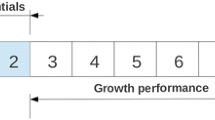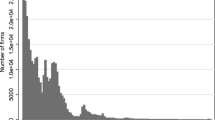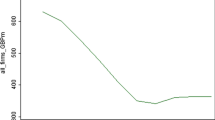Abstract
While there is an increasing interest in the literature about the relationship between profits and business growth, the empirical evidence is mixed and inconclusive. This can be explained by the difficulty of fully addressing the complex nature of this relationship. Building on resource-based and evolutionary considerations, the present study investigates the dynamics between growth and profits of young firms by explicitly considering the endogeneity and heterogeneity aspects of the relationship. Data are based on a cohort of Spanish manufacturing firms tracked during the period 1996–2010. The results indicate that young firm growth has a positive impact on profits. In contrast, the effect of profits on growth is not significant. Neither is there a significant correlation between past and current growth. Importantly, we find that the results are strongly influenced by inter-firm heterogeneity. Implications from these findings are discussed.
Similar content being viewed by others
Notes
Although we recognize that the whole idea of Granger causality that underlies Hurlin’s approach may be criticisable, we consider this test to be of particular importance for testing the existence of inter-firm heterogeneity in the profit–growth relationship.
In order to check for the external an internal validity of this sample, we estimate several tests for proportions (z test) comparing this sample with the initial population drawn from the SABI© registers, the Spanish National Firms Registry (Directorio Central de Empresas) and other comparable statistics on the manufacturing sectors in other EU countries and the US. In all these cases, only few significant differences were found. These tests and tables are not reported here but they are available from the authors under request.
In this case, we use firm AGE instead of YEAR dummies because as Hurlin´s test performs one single equation for each firm, we only have 14 observations, so we do not have enough degrees of freedom to include 14 dummy variables, one for each year. Therefore, we include AGE, which is a variable that controls almost for the same effect of the YEAR dummies since we are dealing with only one cohort.
This idea was suggested by Dr. Walter Sosa Escudero. However, mistakes and omissions remain our responsibility
We thank an anonymous reviewer for this suggestion.
References
Achtenhagen, L., Naldi, L., & Melin, L. (2010). “Business Growth”—Do practitioners and scholars really talk about the same thing? Entrepreneurship Theory and Practice, 34(2), 289–316.
Alessi, L., Barigozzi, M., & Capasso, M. (2013). The common component of firm growth. Structural Change and Economic Dynamics, 26, 73–82.
Arellano, M., & Bond, S. (1991). Some tests of specification for panel data: Monte Carlo evidence and an application to employment equations. Review of Economic Studies, 58(2), 277–297.
Arellano, M., & Bover, O. (1995). Another look at the instrumental variable estimation of error-components models. Journal of Econometrics, 68(1), 29–51.
Atukeren, E. (2008). Christmas cards, Easter bunnies, and Granger-causality. Quality & Quantity, 42(6), 835–844.
Audretsch, D., Klomp, L., Santarelli, E., & Thurik, R. (2004). Gibrat’s law: Are the services different? Review of Industrial Organization, 24(3), 301–324.
Barney, J. (1991). Firm resources and sustained competitive advantage. Journal of Management, 17(1), 99–120.
Barney, J. (1997). Gaining and sustaining competitive advantage. Menlo Park: Addison Wesley.
Blundell, R., & Bond, S. (1998). Initial conditions and moment restrictions in dynamic panel data models. Journal of Econometrics, 87(1), 115–143.
Blundell, R., & Bond, S. (2000). GMM estimation with persistent panel data: An application to production functions. Econometric Reviews, 19(3), 321–340.
Bond, S. (2002). Dynamic panel data models: A guide to micro data methods and practice. Portuguese Economic Journal, 1(February), 141–162.
Bottazzi, G., Coad, A., Jacoby, N., & Secchi, A. (2011). Corporate growth and industrial dynamics: Evidence from French manufacturing. Applied Economics, 43(1), 103–116.
Bottazzi, G., Dosi, G., Jacoby, N., Secchi, A., & Tamagni, F. (2010). Corporate performances and market selection: Some comparative evidence. Industrial and Corporate Change, 19(6), 1953–1996.
Bottazzi, G., Secchi, A., & Tamagni, F. (2006). Financial fragility and growth dynamics of Italian business firms. LEM papers series, 2006/07. http://www.lem.sssup.it.
Bottazzi, G., Secchi, A., & Tamagni, F. (2007). Productivity, profitability and financial fragility: Empirical evidence from Italian business firms (No. 08). LEM working paper series (Vol. 08, p. 35). http://www.lem.sssup.it.
Brännback, M., Carsrud, A., Renko, M., Ostermark, R., Aaltonen, J., & Kiviluoto, N. (2009). Growth and profitability in small privately held biotech firms: Preliminary findings. New Biotechnology, 25(5), 369–376.
Brännback, M., Kiviluoto, N., Carsrud, A., & Östermark, R. (2010). Much ado about nearly nothing? An explorative study on the myth of high growth technology start-up entrepreneurship. Frontiers of Entrepreneurship Research, 30(12), 1–14.
Brush, C. G., Bromiley, P., & Hendrickx, M. (2000). The free cash flow hypothesis for sales growth and firm performance. Strategic Management Journal, 21(4), 455–472.
Capelleras, J. L., & Rabetino, R. (2008). Individual, organizational and environmental determinants of new firm employment growth: Evidence from Latin America. International Entrepreneurship and Management Journal, 4(1), 79–99.
Capon, N., Farley, J., & Hoenig, S. (1990). Determinants of financial performance: A meta-analysis. Management Science, 36(10), 1143–1159.
Cho, H., & Pucik, V. (2005). Relationship between innovativeness, quality, growth, profitability, and market value. Strategic Management Journal, 26(6), 555–575.
Coad, A. (2007). Testing the principle of “growth of the fitter”: The relationship between profits and firm growth. Structural Change and Economic Dynamics, 18(3), 370–386.
Coad, A., & Broekel, T. (2012). Firm growth and productivity growth: Evidence from a panel VAR. Applied Economics, 44(10), 1251–1269.
Coad, A., Frankish, J., Roberts, R., & Storey, D. (2013). Growth paths and survival chances: An application of Gambler’s Ruin theory. Journal of Business Venturing, 28(5), 615–632.
Coad, A., Rao, R., & Tamagni, F. (2011). Growth processes of Italian manufacturing firms. Structural Change and Economic Dynamics, 22(1), 54–70.
Cowling, M. (2004). The growth–profit nexus. Small Business Economics, 22(1), 1–9.
Davidsson, P., Delmar, F., & Wiklund, J. (2006). Entrepreneurship and the growth of firms (p. 240). Cheltenham: Edward Elgar.
Davidsson, P., Steffens, P., & Fitzsimmons, J. (2009). Growing profitable or growing from profits: Putting the horse in front of the cart? Journal of Business Venturing, 24(4), 388–406.
Delmar, F., Davidsson, P., & Gartner, W. B. (2003). Arriving at the high-growth firm. Journal of Business Venturing, 18(2), 189–216.
Delmar, F., McKelvie, A., & Wennberg, K. (2013). Untangling the relationships among growth, profitability and survival in new firms. Technovation, 33(8–9), 276–291.
Dierickx, I., & Cool, K. (1989). Asset stock accumulation and sustainability of competitive advantage. Management Science, 35(12), 1504–1512.
Dosi, G. (2005). Statistical regularities in the evolution of industries. A guide through some evidence and challenges for the theory. LEM working paper series, 17. http://www.lem.sssup.it/.
Dumitrescu, E., & Hurlin, C. (2012). Testing for Granger non-causality in heterogeneous panels. Economic Modelling, 29(4), 1450–1460.
Erdil, E., & Yetkiner, I. H. (2009). The Granger-causality between health care expenditure and output: A panel data approach. Applied Economics, 41(4), 511–518.
Garnsey, E. (1998). A theory of the early growth of the firm. Industrial and Corporate Change, 7(3), 523–556.
Garnsey, E., Stam, E., & Heffernan, P. (2006). New firm growth: Exploring processes and paths. Industry & Innovation, 13(1), 1–20.
Geroski, P. (1998). An applied econometrician’s view of large company performance. Review of Industrial Organization, 13(3), 271–294.
Geroski, P. (2005). Understanding the implications of empirical work on corporate growth rates. Managerial and Decision Economics, 26(2), 129–138.
Gilbert, B. A., McDougall, P. P., & Audretsch, D. B. (2006). New venture growth: A review and extension. Journal of Management, 32(6), 926–950.
Goddard, J., Tavakoli, M., & Wilson, J. O. S. (2009). Sources of variation in firm profitability and growth. Journal of Business Research, 62(4), 495–508.
Granger, C. W. J. (2003). Some aspects of causal relationships. Journal of Econometrics, 112(1), 69–71.
Hernández-Cánovas, G., & Martínez-Solano, P. (2008). Relationship lending and SME financing in the continental European bank-based system. Small Business Economics, 34(4), 465–482.
Hölzl, W. (2014). Persistence, survival, and growth: A closer look at 20 years of fast-growing firms in Austria. Industrial and Corporate Change, 23(1), 199–231.
Hood, M. V, I. I. I., Kidd, Q., & Morris, I. (2008). Two sides of the same coin? Employing Granger causality tests in a time series cross-section framework. Political Analysis, 16(3), 324–344.
Hurlin, C. (2007). Testing Granger causality in heterogeneous panel data models with fixed coefficients. LEO Documents de Recherche, 10. http://www.univ-orleans.fr/leo/.
Hurlin, C., & Venet, B. (2008). Financial development and growth: A re-examination using a panel granger causality test. LEO Documents de Recherche, 9. http://hal.archives-ouvertes.fr/.
Im, K. S., Pesaran, H. M., & Schin, Y. (2003). Testing for unit roots in heterogeneous panels. Journal of Econometrics, 115(1), 53–74.
Jang (Shawn), S., & Park, K. (2011). Inter-relationship between firm growth and profitability. International Journal of Hospitality Management, 30(4), 1027–1035.
Lee, S. (2014). The relationship between growth and profit: Evidence from firm-level panel data. Structural Change and Economic Dynamics, 28, 1–11.
Lockett, A., Wiklund, J., Davidsson, P., & Girma, S. (2011). Organic and acquisitive growth: Re-examining, testing and extending Penrose’s growth theory. Journal of Management Studies, 48(1), 48–74.
López-Gracia, J., & Sogorb-Mira, F. (2008). Testing trade-off and pecking order theories financing SMEs. Small Business Economics, 31(2), 117–136.
Mason, C., & Stark, M. (2004). What do investors look for in a business plan? A comparison of the investment criteria of bankers, venture capitalists and business angels. International Small Business Journal, 22(3), 227–248.
Nakano, A., & Kim, D. (2011). Dynamics of growth and profitability: The case of Japanese manufacturing firms. Global Economic Review, 40(1), 67–81.
Nelson, R. R. (1991). Why do firms differ, and how does it matter? Strategic Management Journal, 12(S2), 61–74.
Nelson, R. R. (1995). Recent evolutionary theorizing about economic change. Journal of Economic Literature, 33(1), 48–90.
Nelson, R. R., & Winter, S. G. (1982). An evolutionary theory of economic change. Cambridge: Belknap Press.
Nickell, S. (1981). Biases in dynamic models with fixed effects. Econometrica, 49(6), 1417–1426.
Nunes, P. M., Gonçalves, M., & Serrasqueiro, Z. (2013). The influence of age on SMEs’ growth determinants: Empirical evidence. Small Business Economics, 40(2), 249–272.
Parker, S. C., Storey, D. J., & Witteloostuijn, A. (2010). What happens to gazelles? The importance of dynamic management strategy. Small Business Economics, 35(2), 203–226.
Pearl, J. (2009). Causal inference in statistics: An overview. Statistics Surveys, 3, 96–146.
Peneder, M. R. (2007). Firm entry and turnover: The nexus with profitability and growth. Small Business Economics, 30(4), 327–344.
Penrose, E. (1959). The theory of the growth of the firm. Oxford: Basil Blackwell.
Peteraf, M. (1993). The cornerstones of competitive advantage: A resource-based view. Strategic Management Journal, 14(3), 179–191.
Peteraf, M., & Barney, J. (2003). Unraveling the resource-based tangle. Managerial and Decision Economics, 24(4), 309–323.
Reid, G. C. (1995). Early life-cycle behaviour of micro-firms in Scotland. Small Business Economics, 7(2), 89–95.
Roodman, D. (2006). How to do xtabond2: An introduction to difference and system GMM in Stata. Center for global development working paper, (103). www.cgdev.org.
Roodman, D. (2009). A note on the theme of too many instruments. Oxford Bulletin of Economics and Statistics, 71(1), 135–158.
Roper, S. (1999). Modelling small business growth and profitability. Small Business Economics, 13(3), 235–252.
Shepherd, D., & Wiklund, J. (2009). Are we comparing apples with apples or apples with oranges? Appropriateness of knowledge accumulation across growth studies. Entrepreneurship Theory and Practice, 33(1), 105–123.
Short, J., Ketchen, D. J, Jr, Palmer, T., & Hult, T. (2007). Firm, strategic group, and industry influences on performance. Strategic Management Journal, 28(2), 147–167.
Srholec, M., & Verspagen, B. (2012). The Voyage of the Beagle into innovation: Explorations on heterogeneity, selection, and sectors. Industrial and Corporate Change, 21(5), 1221–1253.
Stam, E. (2010). Growth beyond Gibrat: Firm growth processes and strategies. Small Business Economics, 35(2), 129–135.
Steffens, P., Davidsson, P., & Fitzsimmons, J. (2009). Performance configurations over time: Implications for growth- and profit-oriented strategies. Entrepreneurship Theory and Practice, 33(1), 125–148.
Storey, D. (2011). Optimism and chance: The elephants in the entrepreneurship room. International Small Business Journal, 29(4), 303–321.
Sutton, J. (1997). Gibrat’s legacy. Journal of Economic Literature, 35(1), 40–59.
Teruel-Carrizosa, M. (2008). Gibrat’s law and the learning process. Small Business Economics, 34(4), 355–373.
Weinzimmer, L. G., Nystrom, P. C., & Freeman, S. J. (1998). Measuring organizational growth: Issues, consequences and guidelines. Journal of Management, 24(2), 235–262.
Wernerfelt, B. (1984). A resource-based view of the firm. Strategic Management Journal, 5(2), 171–180.
Westhead, P., & Wright, M. (2011). David Storey’s optimism and chance perspective: A case of the Emperor’s new clothes? International Small Business Journal, 29(6), 714–729.
Wiklund, J., Davidsson, P., & Delmar, F. (2003). What do they think and feel about growth? An expectancy-value approach to small business managers’ attitudes toward growth1. Entrepreneurship Theory and Practice, 27(3), 247–270.
Wilcox, J. (1971). A Gambler’s ruin prediction of business failure using accounting data. Sloan Management Review, 12(3), 1–10.
Windmeijer, F. (2005). A finite sample correction for the variance of linear efficient two-step GMM estimators. Journal of Econometrics, 126(1), 25–51.
Acknowledgments
We want to express our gratitude to Luis Trajtenberg, Gabriel Montes-Rojas and Walter Sosa Escudero for their useful comments on the econometric analysis. Also, we want to thank Christophe Hurlin, Erkan Erdil and Irwin Morris for sharing their routines and commands, and the attendees at the SIDPA Seminar—Faculty of Economics, University of Buenos Aires for their valuable comments. We appreciate the support from Associate Editor Alexander Kritikos and the valuable comments from two anonymous referees. Support from the Spanish Ministry of Science and Technology is also acknowledged (Project ECO2010-21242-C03-01). The authors are jointly responsible for the work. The usual disclaimer applies.
Author information
Authors and Affiliations
Corresponding author
Rights and permissions
About this article
Cite this article
Federico, J.S., Capelleras, JL. The heterogeneous dynamics between growth and profits: the case of young firms. Small Bus Econ 44, 231–253 (2015). https://doi.org/10.1007/s11187-014-9598-9
Accepted:
Published:
Issue Date:
DOI: https://doi.org/10.1007/s11187-014-9598-9




